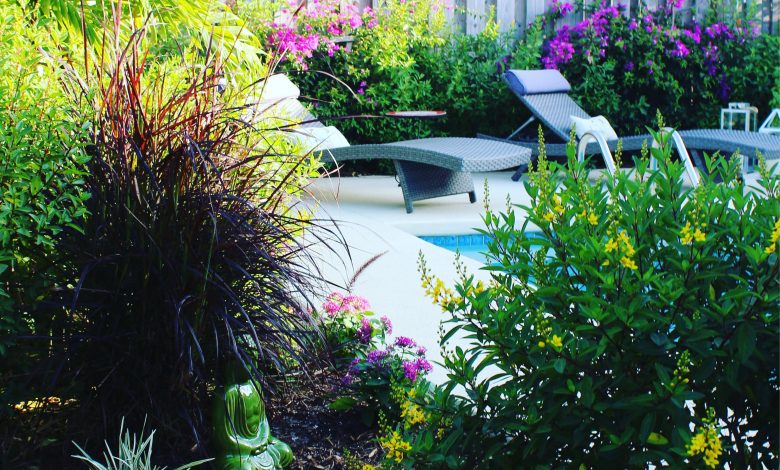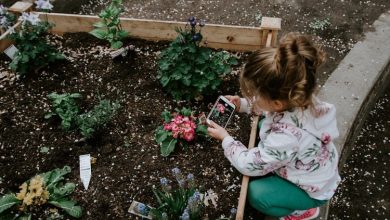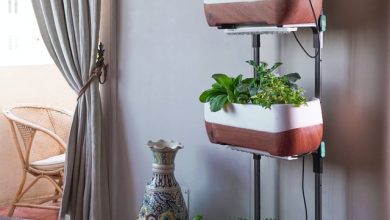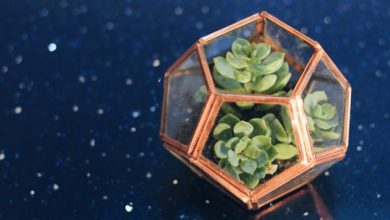Garden Design Principles

Perhaps you are moving into a new home? Or maybe you are looking to give your home a facelift? Either way, designing new gardens is an excellent way to add curb appeal to a home, and you may want to tackle some design yourself. In this article, we discuss some basic concepts for garden design. We also discuss different types of plants that are suitable for any garden.
Create a garden that you are proud of but more importantly, create a garden that is going to represent what you want – and one way of doing that is knowing the basics of how to have a thriving garden.
Sun Exposure
One of the most critical factors in garden design is sun exposure, as you may have expected. It is not necessary for a yard to have full sun. In fact, many low light plants can be used to create beautiful shade gardens. You need to know where the sun is so that you can plan for the proper plants to go in suitable spots.
It is likely that areas of your yard are full sun, while some are full shade, and there are likely areas in between. No matter the area, some plants can thrive. To make proper plant selection, take a look at your yard at different times of the day. Note areas that have morning sun, afternoon sun, or no sun at all. From there, you can start to choose plants that fit within those light standards.
Choose full sun plants for areas that get intense afternoon sun. Partial sun plants do well in areas with morning sun only. And obviously, shade plants are for shady areas. It is essential to understand that sun exposure affects flower power. For full sun plants, this means more sun equals more flowers. The plant can usually grow in lower light levels, but they won’t have as many flowers. The same is not true for low light plants located in the sun. These plants cannot tolerate the direct heat of the sun and tend to burn up and die. Providing extra water can help mitigate this burning, but the plant likely won’t survive long.
Remember, sun exposure can dictate what kind of plants you plant and if your garden is going to be able to thrive and survive. If the space does not have much sun exposure, consider alternative ways of providing sunlight. This may include installing special lights to ensure that they get enough to do what they to do.
Leaf Color
A great theme when planning a garden is leaf color. It may be easy to think all leaves are green, but this is simply not true. Many plants come in red or purple leaves. Some are variegated with yellow or white. Some are even yellow in color. Choosing plants for a design should revolve around some sort of theme or idea. Leaf color is one of those themes. Having the same color repeat itself throughout the garden helps bring cohesion to the design. If you are planning a theme around color, it is crucial to use the color of the leaf, not the flower. Flowers persist on plants for a limited period of time. The color of the leaf continues for most of the growing season, making the leaf color more important. Here are some examples of plants with unique leaf colors:
- Purple Leaf Sandcherry: As the name suggests, this shrub sports purple leaves all season. In the spring, the plant really pops with pink and white flowers. Growing at most eight feet tall, this is an stunning shrub.
- Variegated Dogwood: Many dogwoods come with white and green variegated leaves. Depending on the variety, dogwoods can grow as little as five feet and up to ten feet. As an added bonus, some dogwoods have beautiful red bark that really stands out during winter months.
- Golden Euonymus: A euonymus is a broadleaf evergreen. This means it keeps its golden leaves year-round. Usually a low grower, this plant maxes out at three feet tall. Some varieties are able to climb other plants and hard surfaces, so be sure to know what you are purchasing.

Garden Shape
The shape of a garden is just as important as what goes in it. Garden shapes should be pleasing to the eye and should reflect features in a home. Look at the shape of a home to pick up on visual cues. For example, some homes are constructed with peaked roofs, while others have very flat roofs. Other homes are built out of sweeping arches or long curving lines. Picking up on these character traits can help decide what shapes your gardens should be.
Traditionally, many gardens are constructed with curvilinear lines. This means edges are made up of long, curving lines that tend to swing back and forth on themselves. Curvilinear beds make for attractive gardens. The change in width allows for larger plants mixed in with smaller plants. It also adds a visual dynamic because the human eye is drawn to and pleased by the soft curving lines. A curvilinear design is an appropriate choice for large properties. It takes the eye through all aspects of the property, giving a genuine appreciation for the house and landscape. Curvilinear lines are also easier to install and maintain. The edges are more comfortable to follow and keep clean because they are somewhat forgiving.
Now more than ever, homes are designed in a contemporary style. In this type of design, rooflines, windows, and doors have immaculate, straight lines. Though it is more complicated and generally expensive, it is possible to reflect the clean lines in a garden bed. Straight lines are quite tricky to install and maintain naturally. If a line bows out in any way, it is incredibly noticeable. Because of this, the best way to create straight-lined gardens is through stone edging or retaining walls. Obviously, installing a garden wall is more expensive due to the materials and labor required. However, the cost is worth it in order to maintain the integrity of the clean lines.
One way of knowing what kind of garden shape is best for your specific space and plot of land is to consult professionals or look up landscape magazines for inspiration. Should you go the professional route, consider having your ideas and what you want written down, as this is going to help the landscapers and gardeners. Another way of preparing and determining your garden shape, especially when collaborating with specialists, is ensuring that they come on-site to visit the space. Doing it this way means that they can make recommendations and suggestions – because sometimes what we want and think looks good isn’t always feasible or realistic.
Garden Location
Where a garden is located in a yard is another essential factor in design. Gardens should be placed in spots that make sense for visual appeal, maintenance, and longevity. Keeping these three factors in mind helps to make decisions as to where to put a garden. For example, a large home should have extensive gardens that sweep through the property. A small garden located tight to the house would look out of place because of the significant difference in size. Again, it is important to use features of the building and reflect them in the landscape.
There are several places a garden should be located and several places they should not. However, this can depend on your climate. Gardens tend to be located right up against the home and under front windows. This is a good spot because it adds drama to the home and breaks up the repetitive facade of the house. In addition, grass tends to struggle to grow near building walls and under eavestroughs. Larger shrubs with ample room to spread their roots do better up against a house than grass.
Gardens also tend to line walkways. This is another good spot because the plants soften the harsh stone of the front walk. Gardens here create a welcome entry point to the house. Another appropriate place for a garden can be near the property line. Gardens here create a definition between your home and the neighbors. Large trees or shrubs can be planted to give privacy or block out unwanted views.
So where shouldn’t a garden be located? This is mainly dependent on the climate. If you live in a place where you get snow, avoid putting gardens right against the road. When the streets are cleared, snow tends to be pushed back onto properties, sometimes creating damage. Lawns are much easier and more cost-effective to repair. Replacing the same plants each year is mentally wearing and gets expensive.
It is also a good idea to avoid lining a driveway with gardens. Again, snow needs to go somewhere. It is likely that the snow is piled right next to the laneway and therefore would build up on top of plants. Laneways also tend to narrow throughout the winter with the accumulation of snow. Shrubs right next to the driveway only make it harder to access the drive in an already difficult situation. If you have your heart set on a garden adjacent to the driveway, then be sure to plant only salt-tolerant perennials. Shrubs should be kept towards the other side of the garden where they won’t get damaged or obstruct views.
Garden location is just as important as considering the amount of sun exposure. As mentioned, it is important to consider your space and the surroundings. You don’t want to plant a garden underneath or overly close to a tree that may provide too much shade, or its needles may prevent the flowers from growing. If you live in a high-rise or are limited in land, it is still very much possible to have your own little garden; the one big difference is it may require some creativity. For example, rather than planting on flat land and soil, a garden that is done inside may use special equipment, such as a trellis or a plant shelf. Don’t feel as though you can’t have a garden just because you don’t have the traditional plot of land – anything is possible.
Plant Growth Habit
The shape a plant grows can be an excellent way to choose what plants belong in a garden. Plant shape is often referred to as its growth habit. Its habit describes what form the plant naturally grows into. It is best to have a mixture of plant shapes while repeating one shape several times. It would not do your garden well to have only one style. Could you imagine a garden made up of only weeping shrubs? It would look like a yard made up of umbrellas. However, using several weeping plants and peppering in other shapes is very visually appealing. Common growth habits themes are columnar, weeping, fountain, and globe or rounded.
Columnar Plants
Columnar plants stand tall and straight. They make for an excellent way to draw the eye upwards. Columnars are also ideal for small spaces. There are varieties that grow quite tall but don’t take up much width. Newer homes tend to have less yard space, so columnars do well for those homes.
Weeping Plants
Weeping plants are round and umbrella shaped. The branches grow out of the stem and back towards the ground. These make for ornamental plants and therefore can be a crucial feature in a landscape. As a plus, there is a wide array of weeping plants available in many sizes. So whether you have a large or small yard, you can likely find a weeping plant for space.
Fountain Shaped Plants
Fountain shaped plants have long sprawling branches that reach out from the center of the plant. The tips hang towards the ground, giving the plant the effect of a spraying water fountain. Plants with this growth habit tend to take up more space in a garden, so they are good in large spaces. They are also well used for blocking unsightly views, like a neighbor’s shed or patio. These plants tend to have small flowers that line the branches, making for a true spectacle when in full bloom.
Globed Plants
Globed plants are rounded in shape. These plants tend to have a more formal appeal due to their tightly held edges. Again, globed plants can be either large or small, so choosing the correct variety is very important. However, their versatility in size makes them excellent for just about any yard. Globe shaped plants may look untidy when left to grow naturally. They may require more maintenance and pruning than other plants. But when done regularly, the time commitment is minimal, and the result is worth it.

Other Garden Features
When we refer to gardens, we immediately think of plant material. Gardens can be so much more than just plants, and a well-designed one incorporates other features. To create visual interest, try to break up the abundance of plants. The repetition of plant after plant gets boring. Boulders and stones placed strategically throughout the garden is a great way to do this. Firstly, boulders have a different color than the plants. Secondly, the change in texture creates a contrast pleasing to the human eye. Boulders can also be an excellent spot for hummingbirds and butterflies to perch. So if you are one to enjoy these wildlife friends, then definitely include a few stones in your design.
Water features are steadily becoming more popular in landscape design. A simple bubbling stone can be purchased from any home improvement store. If you like something a little more whimsical, consider adding a water fountain to the yard. Water features are available in many designs and sizes, so you can likely find one to fit your taste. Significant water features with even more visual impact are also options for the garden. Depending on the size, it may need to be installed by a professional, so keep this in mind when purchasing.
Stepping stones can also be placed throughout a garden. These are great for large garden areas. Stones, usually flagstones, can help take a visitor on a journey through the garden. So often, plants are better enjoyed closer up, especially sweet-smelling ones. Giving a person a proper path to follow allows for an up-close look without ruining neighboring plants. Stepping stones can also provide a short-cut through the yard or delineate the path you want someone to take.
Depending on the location of the garden, a person sometimes has no option but to walk through it. So, steps can help to keep the plant material safe. Flagstones are one of the best choices for stepping stones due to their flat surfaces. They are available in greys and beiges with hints of whites and pinks. Natural versions of this stone last for decades but can be expensive. There are man-made precast versions available at most home improvement stores. They are less expensive so an excellent substitute when the cost is a factor in decision making.
When you start to incorporate other garden features, it can start to increase your expenses; however, remember, that you also don’t want to go with the cheapest options, as this can actually cost you more in the end. Just as planning a garden requires preparation, so does the installation of garden features. From the rocks and their placement, to the water features, make a plan for your budget, but also make a plan for where you want them placed.
Design Goals
Overall, it is your goal to design gardens that are cohesive and interesting. For each person, this may mean something different. Proper planning can help to work out what you are looking for in a garden. Ask yourself questions to better understand how you want your garden to look. For example, what colors do you like? Do you have any favorite plants? Do you like it when gardens are full of plants, or do you prefer contemporary, clean lines? Look through magazines, do internet searches, and check out neighboring homes to see what you find attractive. The best way to achieve this is by combining elements of each topic above. A good garden design celebrates many different features to create a visually appealing outdoor experience.
Remember that gardens can develop over time. Having a basic structure can help when making decisions to add to your garden. Getting to know the plants in your garden also helps when putting in additional plants and features. You may find that some plants require too much work, or you may think that others look messy when in flower. Use this knowledge to help expand the use of your landscape and choose additions that are better suited to your preferences.
Designing and installing a unique garden adds curb appeal and increases the value of a home. Do your research and plan ahead to make the most of your most significant and most valuable investment.



